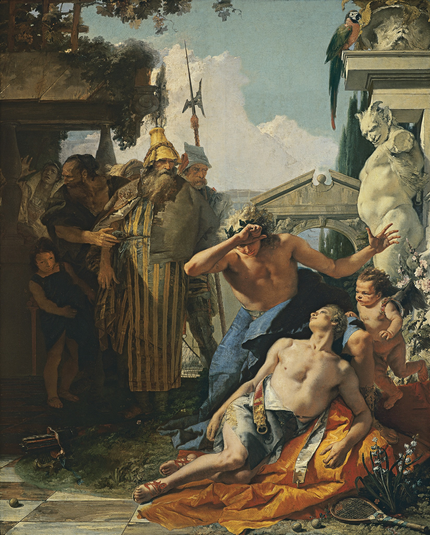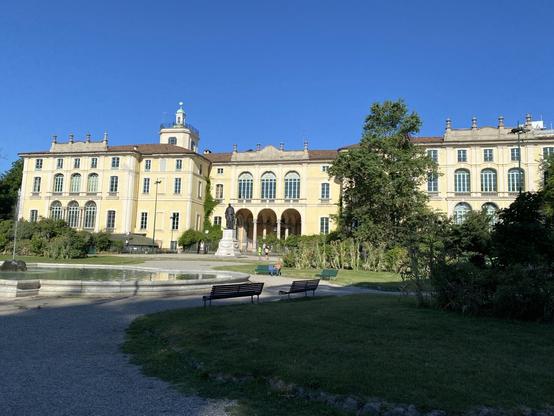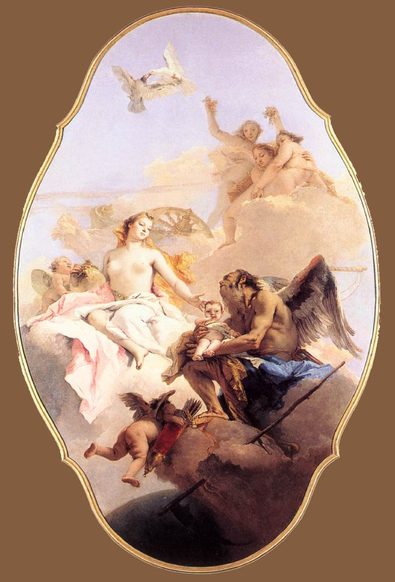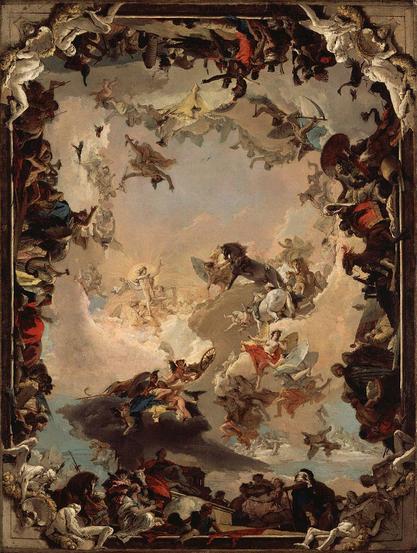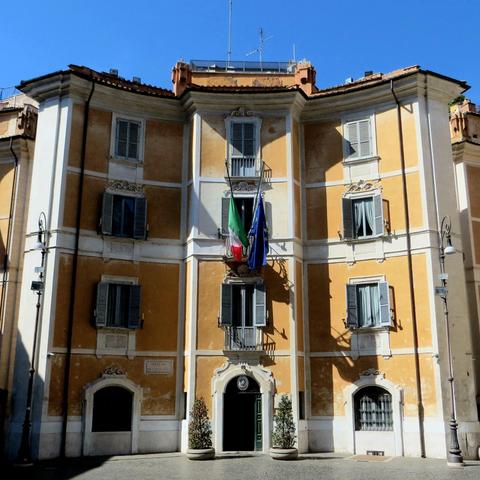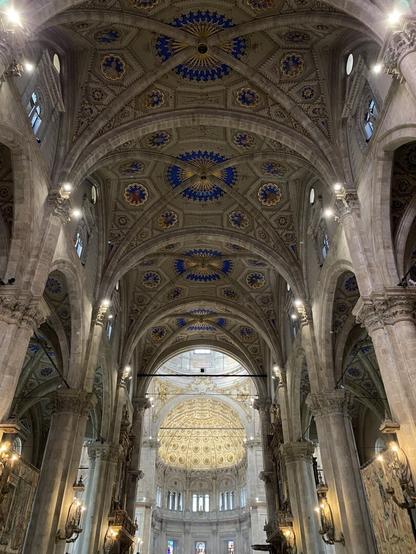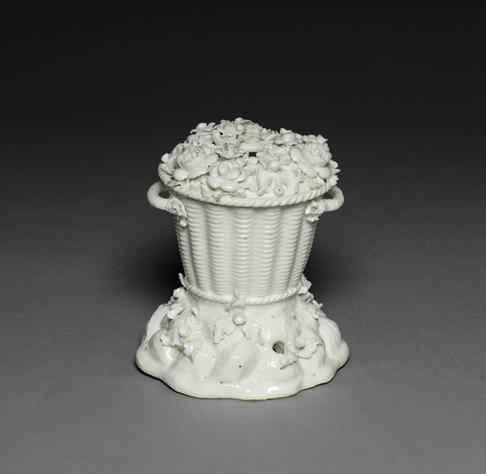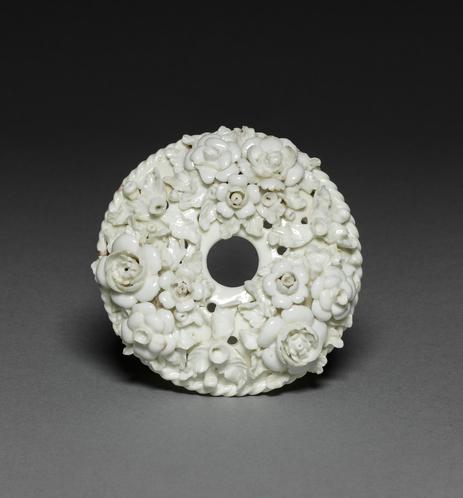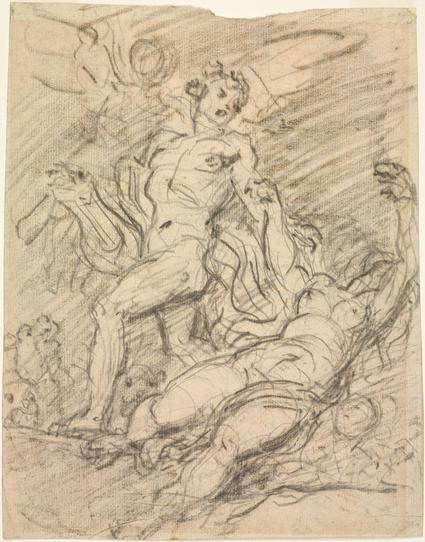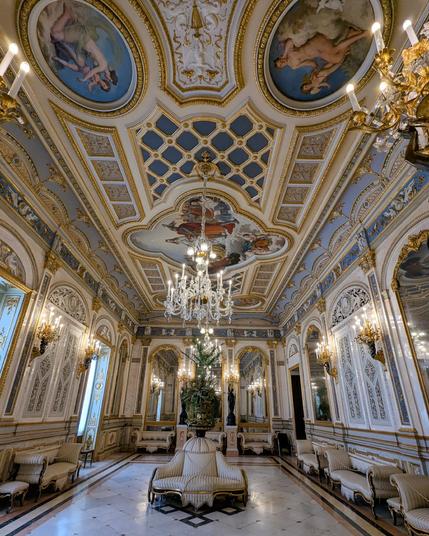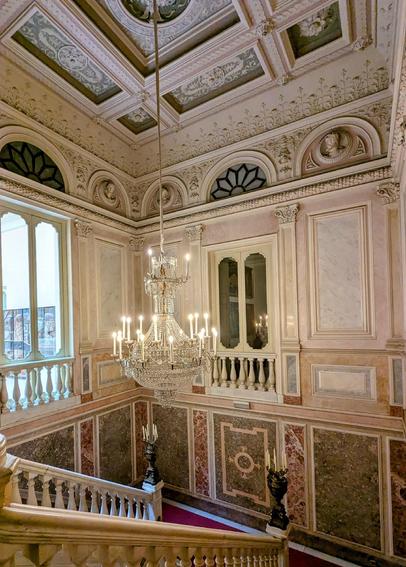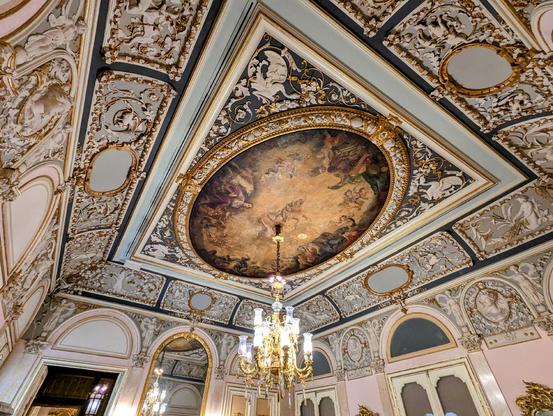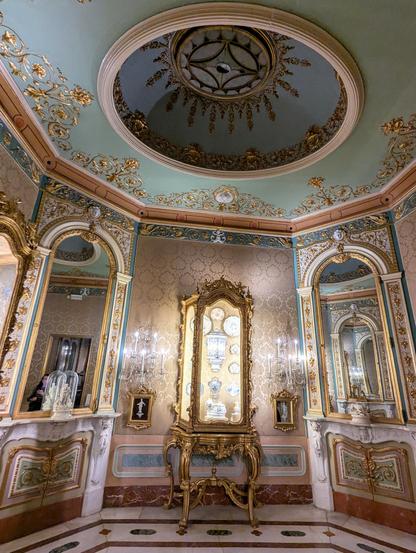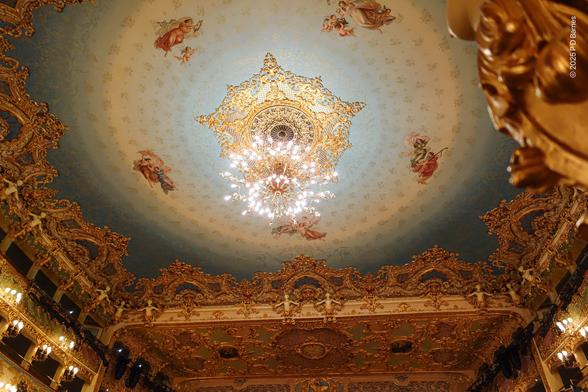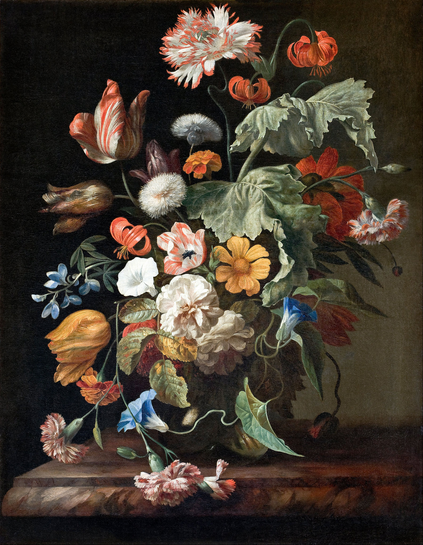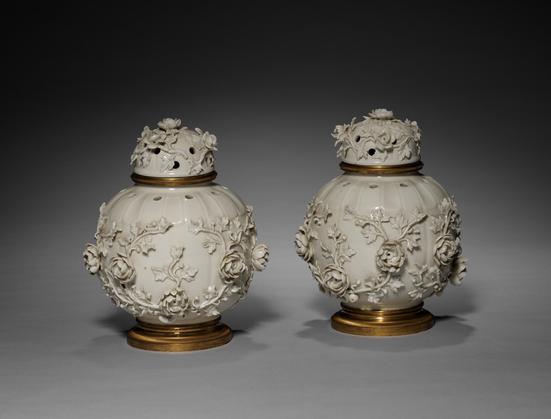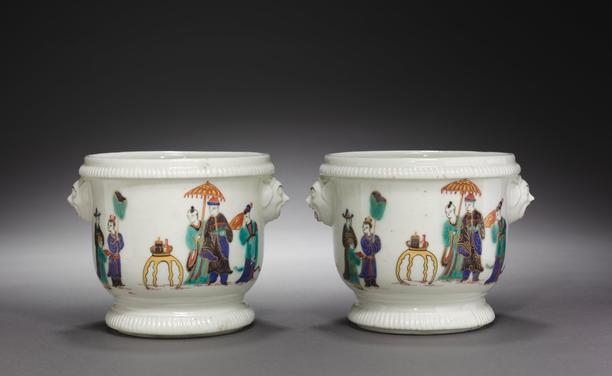@my_millennium Thank you very much for the valuable comment 🙏! I’ve incorporated your correction directly into the first paragraph of the Historical background section, where the palace’s #Rococo character is now more clearly acknowledged 😊👍
#rococo
The McMansionization of the #WhiteHouse, or: Regional Car Dealership Rococo: a treatise | @mcmansionhell
"The Death of Hyacinthus," Giovanni Battista Tiepolo, 1752-53.
I once heard Rococo as "Baroque being frivolous" and while this painting is pretty tragic, it's also unintentionally funny.
Tiepolo (1696-1770) was a prolific Venetian painter who also worked in Spain and Germany, with examples of his art being found all over the place. After his death, the rise of severe Neoclassicism meant his style was no longer in vogue, but today he's regarded as an exceptional decorative painter, perhaps not of great depth, but with exceptional technique.
Here we have a scene from Greek myth. Apollo loved the beautiful youth Hyacinthus, and one day, while playing with a discus, either Hyacinthus botched a throw, or Apollo botched a throw, or an errant wind from a jealous Zephyrus caused the discus to hit Hyacinthus, killing him. Apollo, in his grief, turned him into the hyacinth flower, which we see in the lower right corner...next to a tennis racket. Yup, in this painting they were playing tennis! Supposedly a translation of Ovid of the time changed "discus" to "tennis" which seems bizarre today.
From the Museo Nacional Thyssen-Bornemisza, Madrid.
#Art #GiovanniBattistaTiepolo #Rococo #Mythology #HyacinthusPlayingTennis
Giambattista Tiepolo
An Allegory with Venus and Time
1754-58
Oil on canvas, 292 x 190 cm
National Gallery, London
One of my favourite pictures from London's National Gallery. I confess I often hold this picture in my mind's eye as a form of escapism -- an escape from strip malls, bloated SUVs, megachurches with fundamentalist PowerPoints punctuated by bad rock and extempore prayer, cargo pants,
presidential make up, the Hobby Lobby...
#Tiepolo #GiambattistaTiepolo #NtationalGallery #VenetianArt #Painting #LateBaroque #Rococo #Art #Allegory #Venus #Escapism
'Allegory of the Planets and Continents' by Giovanni Battista Tiepolo (1752)
#painting #paintings #artist #artists #arthistory #rococo #artlover #artlovers #artnet #museum #gallery #galleries #artmuseum #artmuseums #artnet
Untangling the EU Flag. Piazza Sant'Ignazio in #Rome, 1728 #WindowFriday #FensterFreitag #photography #architecture #ornaments #rococo #baroque
(Wow) is indeed a mixture of #Gothic, #Renaissance and #Rococo
#art #architecture #photo #pic #church #travel
Arte «La Pradera de San Isidro-Francisco de Goya»
Pintura: La pradera de San Isidro – Francisco de Goya
Título original: La pradera de San Isidro
Título en español: La pradera de San Isidro
Autor: Francisco de Goya
Estilo pictórico: Rococó
Siglo y año: Siglo XVIII, 1788
País: España
Género: Costumbrista, paisaje urbano
Descripción
«La pradera de San Isidro» es un boceto de Francisco de Goya, pintado como parte de una serie de cartones para tapices destinados a decorar el dormitorio de las infantas en el Palacio de El Pardo1. Esta obra, de pequeñas dimensiones (41,9 x 90,8 cm), es un óleo sobre lienzo que se encuentra actualmente en el Museo del Prado3.
La pintura representa una vista panorámica de Madrid desde la ermita de San Isidro, patrón de la ciudad, durante el día de la romería1. En primer plano, se muestra una multitud disfrutando de la festividad, mientras que al fondo se aprecia el perfil de la ciudad de Madrid3.
Características destacadas:
- Perspectiva: Goya logra una gran sensación de espacio y profundidad, mostrando una vista realista de la topografía de Madrid1.
- Elementos arquitectónicos: Se pueden distinguir edificios emblemáticos como el Palacio Real, la cúpula de San Francisco el Grande, y los puentes de Toledo y Segovia13.
- Colorido: La obra utiliza una gama de tonos blancos, rosados, verdes y azules, con toques de rojo para dar variedad1.
- Técnica: Goya emplea una imprimación de gama fría, innovando respecto a su primera época, lo que resulta en tonos dorados venecianos, perlas, grises y rosados1.
- Composición: La escena está organizada en varios planos, con grupos de figuras en primer término que sirven como marco para la vista de la ciudad1.
A pesar de ser un boceto inacabado debido a la muerte de Carlos III, esta obra se ha convertido en un modelo iconográfico del Madrid goyesco, capturando magistralmente la atmósfera festiva y el paisaje urbano de la época13.
Citas:
- https://es.wikipedia.org/wiki/La_pradera_de_San_Isidro
- https://www.lavanguardia.com/historiayvida/mas-historias/20220515/8264781/asi-cambiado-pradera-san-isidro-recorrido-traves-arte-pmv.html
- https://www.museodelprado.es/coleccion/obra-de-arte/la-pradera-de-san-isidro/290d61bb-59ac-49e5-a63f-390eb5bdde46
- https://palios.wordpress.com/2021/09/25/la-pradera-de-san-isidro-y-el-coloso-goya/
- https://www.museodelprado.es/coleccion/obra-de-arte/la-pradera-de-san-isidro/4fd75ccc-f882-4998-9e73-73d7fe18086c
- https://fundaciongoyaenaragon.es/obra/la-pradera-de-san-isidro-1/73
- https://www.almendron.com/artehistoria/arte/pintura/goya-realidad-e-imagen/la-pradera-de-san-isidro/
- https://www.youtube.com/watch?v=PbKUx_Vntao
Respuesta de Perplexity: pplx.ai/share
#costumbrista #dailyprompt #FranciscoDeGoya #paisajeUrbano #pintura #Rococó
The Potpourri Vase with Cover exemplifies Rococo elegance, blending form and function. Its delicate floral motifs and intricate basket design invite not just admiration but also an aromatic experience. How do scents influence your perception of art?
#ClevelandArt #Rococo #Porcelain
https://clevelandart.org/art/1962.360.1
This exquisite porcelain cover for a potpourri vase showcases the Rococo's love for nature and elegance, beautifully combining intricate floral designs. How does this piece reflect the era's innovation in porcelain artistry?
#Rococo #PorcelainArt #ClevelandArt
https://clevelandart.org/art/1962.360.1.b
Tiepolo's sketch of Orpheus and Eurydice immerses viewers in the emotional pull of love and loss. The dynamic lines and chiaroscuro ignite a sense of urgency. What story do you see in this captivating moment?
#Art #Rococo #ClevelandArt
https://clevelandart.org/art/2009.152.a
But my favorite thing about the #MuseoNacionaldeCerámicayArtesSuntuarias was the building itself!
#rococo
More cowbell!! Ceiling, La Fenice, Venice #photography #AlphabetChallenge #WeekIforInside #Inside #EastCoastKin #rococo #architecture #decoration
"Still Life with Flowers," Rachel Ruysch, 18th century.
I've talked about Ruysch before, but to recap quickly, she was the best-documented woman painter of her time, with an enormously successful career, getting commissions from many wealthy and influential clients. Poets wrote elegies in honor of her death in 1750, and despite the fact that she specialized in florals, her work was highly praised and fetched high prices after her passing; she even outsold Rembrandt!
The daughter of a scientist and professor of botany, Ruysch depicted plants and flowers with meticulous detail, developing her own style that straddled the line between Baroque and Rococo. Even today, she is regarded as one of the most talented still life artists of all time, bar none.
Happy Flower Friday!
From the Hallwyl Museum, Stockholm.
#Art #DutchArt #WomanArtists #Baroque #Rococo #RachelRuysch #FlowerFriday #Floral #StillLife
#history #architecture #Rococo
#architecture #history #Rococo
The Pair of Potpourri Vases showcases exquisite Rococo elegance, melding intricate floral reliefs and gilded bases. A stunning homage to 18th-century artisanship, their hard-paste porcelain invites scent while captivating the eye. What stories do these vases tell?
#ClevelandArt #ArtHistory #Rococo #Porcelain
https://clevelandart.org/art/2020.200
The Pair of Bottle Coolers from the Saint-Cloud Porcelain Factory beautifully merges Rococo elegance with chinoiserie motifs. Their vibrant colors and unique design reflect a rich cultural exchange. Which aspect of this porcelain masterpiece fascinates you most?
#ClevelandArt #Porcelain #Rococo
https://clevelandart.org/art/1944.226
